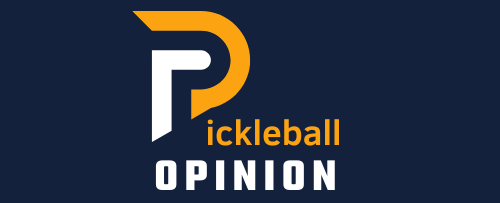How To Hit A Pickleball Forehand-Explore Most Powerful 4 Effective Drills
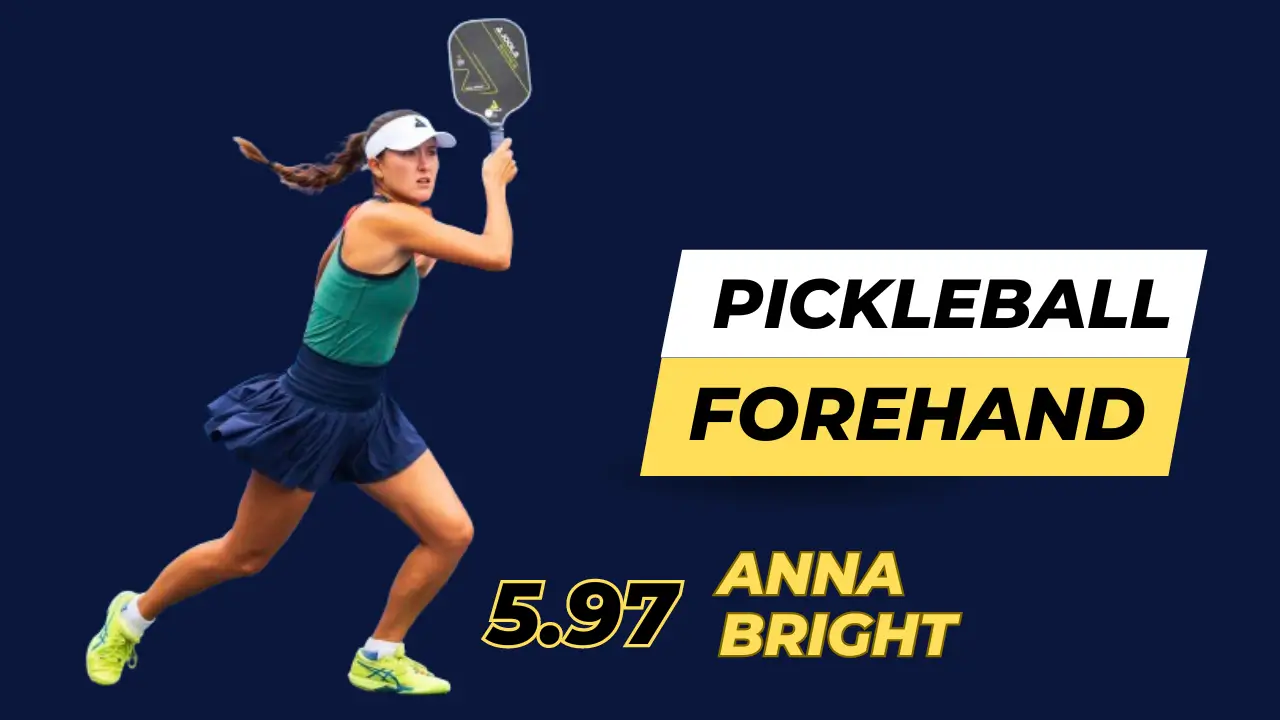
Ever tried hitting a strong pickleball forehand, only to see the ball fly way too high or crash into the net? Get it – it’s frustrating! But guess what? With a bit of know-how and some practice, you can rock the power of forehand and play like a pro. You can also watch the playing style of Ben Johns and Anna Leigh Waters.
To crush a powerful forehand in pickleball, excel at square stance, shoulder-width feet, Eastern grip on the paddle, and a chill yet firm grip. Add some hip and shoulder rotation while swinging for that power boost.
Sure, there’s more to it, but hitting a top-level forehand is that simple. It’s a game-changer too – catch your opponents off guard, spice up your shots, and rule the rally. Mastering the power forehand turns you into a court maestro.
In this article, we’ll dissect the essentials, giving you step-by-step tips to refine your technique. Expert advice awaits, so get ready to unleash your full power.
What is a Pickleball Forehand?
In the game of pickleball, a forehand shot involves striking the ball with the front of your hand directed towards the net. You can use forehands for different shots like hitting the ball off the bounce, hitting it in the air, or making a gentle shot close to the net called a “dink.” For lots of players, the forehand is their favorite shot because it just feels like the most natural way to play. It’s like the move that comes most easily to them.
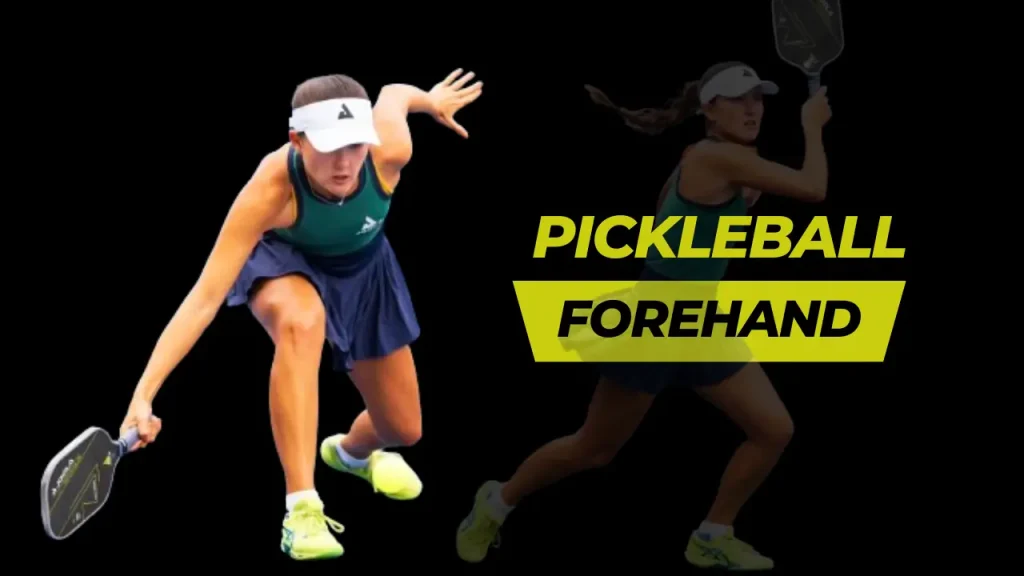
How Do You Hit A Forehand In Pickleball?
For those who are right-handed, pickleball forehand shots are executed on the right side, while left-handed individuals perform forehands on their left side. Either way, your hand is facing the net when you make the shot.
Here’s how to hit a forehand:
- Initiate from the ready position.
- As the ball approaches, position your body so that your left shoulder (or right shoulder for lefties) faces the ball.
- Keep your right hand and pickleball paddle set behind you during the backswing.
- As the ball approaches, align your shoulders squarely with it and gracefully advance by stepping forward with your leading foot.
- Effortlessly guide the paddle through, ensuring it connects with the ball using the paddle head.
- Complete the follow-through of the shot to achieve optimal power and precision.
- Return to the ready position promptly for the next shot.
For beginners, the forehand shot is like the starting point for learning pickleball. It’s the first thing you tackle because hitting forehands feels more natural than backhands.
Now, “forehand” and “backhand” are like big umbrella terms that cover various types of shots. Different forehand and backhand variations are employed for various shots, including groundstrokes, dinks, drives, third-shot drops, pop-ups, and lobs. So, getting the hang of the forehand sets you up for a bunch of cool moves in the game.
How To Hit a Pickleball Forehand Step-By-Step Guide
What Foot Do You Step With When Hitting A Pickleball Forehand?
When gearing up for a forehand groundstroke in pickleball, it’s crucial to take a step forward with your front foot. If you’re right-handed, this means moving your left foot forward, and if you’re a lefty, it’s the opposite – step forward with your right foot.
Now, here’s the trick: pay attention to your back foot. Watch any skilled pickleball pro in slow-motion, and you’ll notice that as soon as they’re ready to strike the ball, they strategically position their back foot behind them. This strategic move isn’t just for show; it’s all about gaining stability, maintaining balance, and generating the power needed to nail that forehand shot.
It’s like a dance move that sets the stage for a winning performance on the pickleball court.
How Do You Hold A Pickleball Paddle For A Forehand Shot?
In the realm of pickleball grips, the eastern grip, commonly referred to as the ‘shake hands’ grip, is frequently seen as the most intuitive option for beginners. In this grip, the paddle face aligns parallel to your palm, creating a seamless extension of your hand. It’s a comfortable and instinctive choice, making the paddle feel like a natural part of your game.
Alternatively, there’s the western grip, affectionately nicknamed the frying pan. In this grip, the paddle head is positioned perpendicular to the palm, resembling the handle of a frying pan.
Lastly, there’s the continental grip. While not as ideal as the eastern grip for forehand shots, it offers more flexibility and sets the paddle face at a favorable angle for executing backhand shots.
For most players, especially those starting, the eastern grip tends to be the most user-friendly and manageable for executing forehand shots effectively.
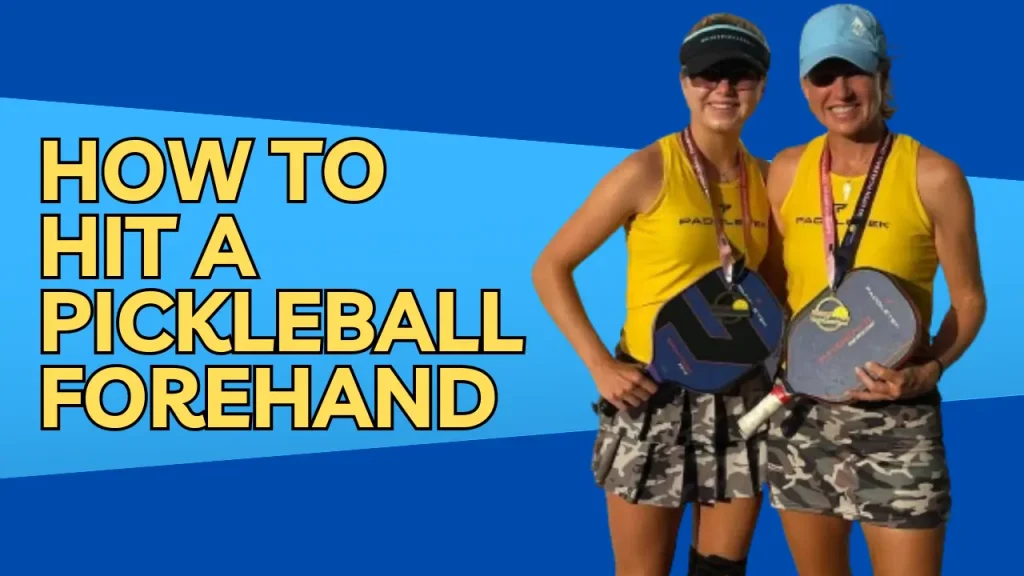
How To Hit A Pickleball Forehand Drive
Pickleball forehand drive is a special way to hit the ball low in pickleball. It’s a strong shot and can be a powerful move for any pickleball player if done right.
To do a pickleball forehand drive:
- Swing the paddle up behind you until it’s about shoulder height.
- Drop the paddle down and hit the ball by swinging from low to high (this is called hitting ‘up’ on the ball).
- This makes the ball spin, going up and then down, making it tricky for the other player to return.
Even though you want to hit the forehand drive with speed, be careful not to hit it too hard. If you try too hard, you might lose control and either hit the net or miss the court. Indeed, in pickleball and many other sports, success often hinges on finding the right balance, whether it’s in terms of grip, technique, strategy, or overall gameplay.
When To Play The Pickleball Forehand Drive?
You do a pickleball forehand drive when the ball bounces before you hit it. Optimal performance is achieved by positioning yourself farther back on the court, closer to the baseline. This positioning allows the ball ample space to travel both upward and downward over the net.
Forehand drives are super useful when you want to hit the ball hard to take advantage of an opening. If your opponent leaves a space in the court, go for a strong forehand drive right into that gap to get the ball past them. It’s like finding the perfect spot and making your move.
How Do I Hit A Pickleball Topspin Forehand?
Why Do We Need Topspin In Pickleball?
Topspin is a valuable technique in pickleball, impacting both the ball’s flight path and its subsequent bounce. This phenomenon, known as the Magnus Effect, causes the ball to dip sharply and sooner compared to a flat shot.
This unique characteristic allows players to hit the ball harder or higher while ensuring it stays within bounds. Additionally, the resulting dip can be strategically utilized to drop the ball short into challenging areas for opponents, as seen in a topspin 3rd shot drop.
When executing a topspin shot, maintain the same swing shape as the basic forehand, but emphasize a steeper forward swing path. Imagine starting from your knees and moving up to your shoulders, as this upward swing path is crucial for generating topspin.
When it comes to the contact point, roll the paddle up the back of the ball, starting from the top and moving down to the bottom. By extending the roll down the paddle and increasing the speed of the paddle movement, you can enhance the spin on the shot. The follow-through mirrors the basic swing, concluding up high with your elbow pointing toward your target area.
Mastering the topspin technique enhances your strategic options on the pickleball court.
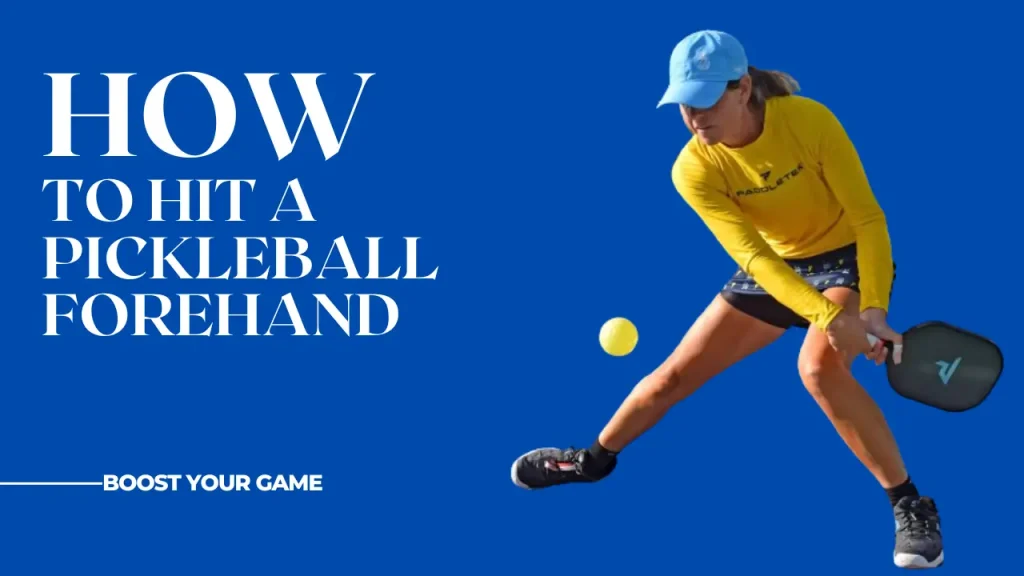
How Do I Hit A Pickleball Forehand Slice?
Employing a slice forehand in pickleball is a strategic maneuver aimed at imparting backspin to the ball. This backspin induces a slowing effect and results in a low bounce, contributing to the tactical execution of the shot. This subtle variation in spin can disrupt your opponent’s timing, particularly when advancing up the court.
It’s a handy shot, allowing you to float the ball low toward your opponent’s feet, creating an opportunity for you to move up to the kitchen. Unlike the topspin, the slice forehand involves a high-to-low backswing, starting with your paddle at shoulder height.
The contact point is the opposite of topspin, with the paddle traveling down the back of the ball. The faster the paddle movement, the more slice is imparted. The follow-through is characterized by a short, frontward motion, finishing lower than the contact point, reflecting the downward striking motion.
In essence, pickleball forehand slice is more than just a spin; it’s a crafty tactic that can give you a strategic edge on the pickleball court.
Pickleball Forehand 4 Effective Drills For Practice
To become a master of both the topspin and slice forehand in pickleball, consistency is the key. Engaging in specific drills can significantly enhance your practice and skill development.
Wall Drills
An effective drill for honing your forehand skills involves hitting the ball against a wall, alternating between flat, topspin, and slice shots. This helps develop versatility and control in your forehand technique. The emphasis here is on getting the technique right and maintaining consistency rather than focusing on power. This exercise allows you to fine-tune your forehand strokes and develop a controlled and precise playing style.
Cross-court Drills
Partner up for a dynamic drill by hitting crosscourt forehands, targeting a specific area. Add variety to your shots by mixing up the spin—alternate between flat, topspin, and slice. This exercise not only sharpens your aim and precision but also enhances your adaptability to different spin variations, making you a more versatile player on the pickleball court.
Consistency Drills
This drill requires a partner, and the goal is to achieve as many consecutive error-free forehand shots as possible. By focusing on maintaining control and consistency, this exercise is excellent for refining your technique and enhancing your overall forehand skills in pickleball.
Control Drills
Arrange targets such as cones or buckets on the court and engage in drills where you aim to hit them using both topspin and slice forehands. This targeted practice is instrumental in refining your accuracy and enhancing paddle control during forehand shots.
It’s essential to bear in mind that these drills are designed to prioritize different aspects of your forehand technique. Resist the urge to solely amplify shot power; instead, concentrate on sustaining proper form, achieving clean contact, and ensuring consistency in shot placement.
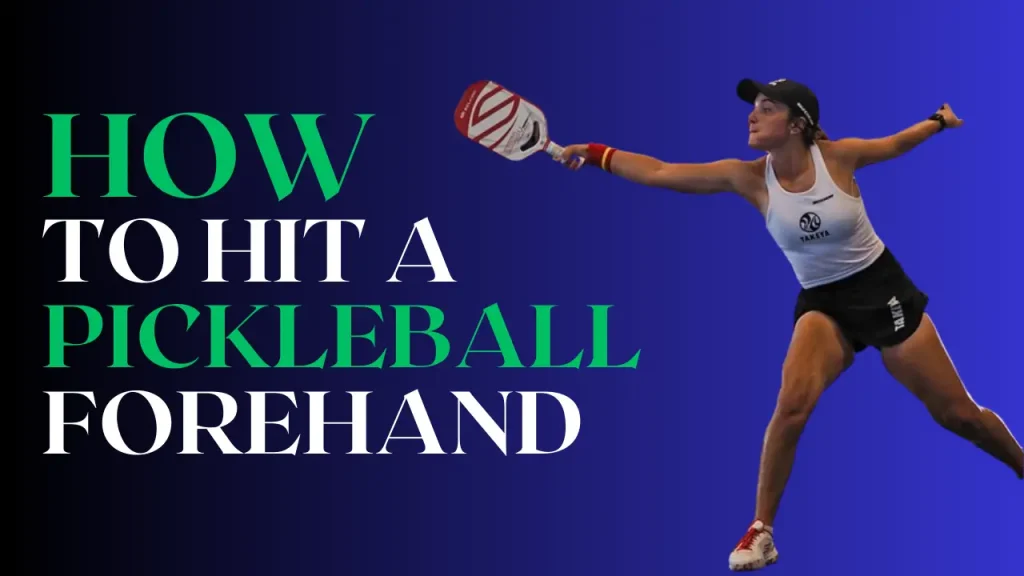
Common Mistakes and How to Avoid Them
Steer clear of these common mistakes to guarantee that your forehand drive boasts both power and accuracy:
Over-Swinging
Engaging in excessive swinging, commonly referred to as over-swinging, can lead to a loss of control and diminished accuracy in your shots. This often occurs when players neglect to follow through properly.
In an attempt to correct this, they might overcompensate, unintentionally causing more harm than good to their shot precision and control.
Rather than over-swinging, concentrate on controlled and fluid motions to generate power while preserving precision. Envision your arm as a whip, smoothly snapping through the shot with a relaxed and well-coordinated motion. This approach ensures a harmonious balance between power and accuracy in your forehand drive.
Poor Ball Contact
Achieving optimal power and precision in your shots relies on striking the ball with the center of the paddle face. The goal is to maximize the sweet spot for the best “pop” in your shot.
Misaligned body position, incorrect timing, or a lack of awareness about the sweet spot on your paddle can lead to poor ball contact. It’s crucial to address these factors to consistently hit the sweet spot and optimize the performance of your forehand drive.
Enhancing ball contact involves honing your footwork and timing to position yourself correctly for a square hit. Practice being in the right spot to connect with the ball, making a deliberate effort to maintain focus on the ball until the exact moment of impact. This attention to footwork, timing, and visual focus contributes significantly to refining the effectiveness of your forehand drive.
Inadequate Follow-Through
Reiterating a crucial point mentioned earlier: many players tend to prematurely halt their swing, leading to a weaker and less controlled shot.
It is vital to ensure that your arm fully extends during the follow-through, with the paddle finishing high and crossing your body. This extended follow-through not only preserves the intended trajectory but also adds more power to your forehand shot, emphasizing the importance of this aspect in achieving an effective and controlled swing.
Rushing the Shot
Another prevalent mistake among players stems from the attempt to infuse more power into the shot. However, in the pursuit of added power, the stroke becomes rushed, compromising the technique. Players who hurry their power forehand sacrifice precision for speed.
To resolve this issue, it is vital to take your time while setting up the shot. Pay attention to proper footwork, weight transfer, and paddle preparation. It’s essential to remember that generating power isn’t solely reliant on arm strength; it involves the entire body working in harmony, with particular emphasis on effective trunk rotation.
By maintaining a deliberate and measured approach, you can strike a balance between power and technique in your forehand shots.
Inconsistent Stance
A consistent stance is key for building muscle memory and a dependable shot. Work on keeping a balanced and stable position, ensuring your feet are shoulder-width apart and your knees slightly bent.
This sturdy stance serves as a reliable foundation, enabling you to generate power and maintain control throughout your swing.
Conclusion
Achieving mastery in the pickleball forehand shot, encompassing both topspin and slice, will undoubtedly elevate your pickleball prowess. While it demands consistent practice and patience, this guide equips you with the necessary knowledge to execute these shots with effectiveness.
Always begin with a firm grip and a well-balanced stance, focusing on the precise point of contact with the ball and a smooth follow-through.
As you refine your forehand technique, anticipate a surge in your ability to deliver winning shots and take control of the game’s pace. So, grab your paddle, hit the court, and embark on honing that next-level forehand! Best of luck on your pickleball journey.
